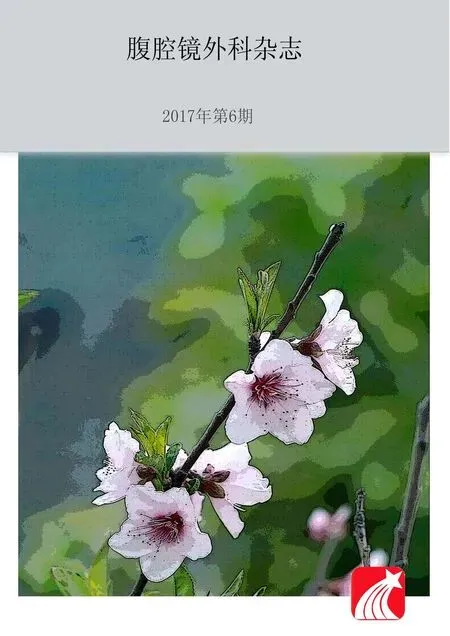罗哌卡因对腹腔镜胆囊切除术中术区不同位置镇痛效果的研究*
刘树旺,张丽芬,刘林森,李 琪,刘利平,彭公泽,刘嘉林(深圳市人民医院,广东 深圳,518020)
·论 著·
罗哌卡因对腹腔镜胆囊切除术中术区不同位置镇痛效果的研究*
刘树旺,张丽芬,刘林森,李 琪,刘利平,彭公泽,刘嘉林
(深圳市人民医院,广东 深圳,518020)
目的:探讨罗哌卡因用于腹腔镜胆囊切除术(laparoscopic cholecystectomy,LC)中切口及腹膜内局部浸润、术区表面麻醉的术后镇痛效果。方法:选择全麻下行LC的60例患者,随机、双盲分为4组。A组:不进行任何处理;B组:手术结束前分别于脐部、剑突下、右肋缘下切口注入0.75%盐酸罗哌卡因2 ml;C组:手术结束前分别于脐部、剑突下、右肋缘下切口下周围腹膜注入0.75%盐酸罗哌卡因2 ml;D组:手术结束前分别在脐部、剑突下、右肋缘下皮肤切口及周围腹膜联合胆囊床、肝膈面喷洒0.75%盐酸罗哌卡因2 ml。4组患者的麻醉诱导、维持方法相同,术后均持续监测呼吸、血压、心率、血氧饱和度,记录术后2 h、6 h、12 h、24 h的疼痛视觉模拟评分及术后恶心、呕吐不良反应的发生率。结果:B、C、D组术后2~12 h的疼痛评分低于A组(P<0.05),D组疼痛评分低于B、C两组(P<0.05);术后恶心、呕吐发生率四组差异无统计学意义(P>0.05)。结论:罗哌卡因用于LC具有良好的镇痛效果,同时联合切口、切口周围腹膜及胆囊床、肝膈面表面喷洒罗哌卡因效果更佳,具有良好的安全性。
罗哌卡因;胆囊切除术,腹腔镜;镇痛
腹腔镜胆囊切除术(laparoscopic cholecystectomy,LC)的优点是损伤小、康复快、住院时间相对较短,现已广泛应用于临床,但由于CO2气腹刺激、腹膜牵拉等因素,术后急性疼痛仍较明显[1]。罗哌卡因是一种新型长效酰胺类局部麻醉药,具有作用时效强,中枢神经系统、心血管系统毒性低的特点[2]。国外对于罗哌卡因用于腹腔镜术后镇痛已有报道[3-5],给药途径包括术中腹腔内喷洒、手术切口局部注射等[6-8]。本研究旨在探讨罗哌卡因对LC患者术区不同位置的镇痛效果及临床可行性。
1 资料与方法
1.1 临床资料 选取2016年3月至2016年6月我院择期行LC的60例患者,其中男28例,女32例,35~61岁。美国麻醉医师协会分级Ⅰ级或Ⅱ级,其中胆囊结石患者52例,胆囊息肉8例;排除对酰胺类局麻药物过敏史,无慢性疼痛史、药物依赖/滥用史、中转开腹、术后放置腹腔引流管的患者。经深圳市人民医院伦理委员会批准,患者随机、双盲分为A、B、C、D四组,每组15例。四组患者性别、年龄、体重、手术时间差异均无统计学意义(P>0.05),见表1。

表1 四组患者一般资料的比较
1.2 麻醉方法 麻醉诱导芬太尼0.1 μg/kg、异丙酚2 mg/kg、顺式阿曲库铵0.2 mg/kg,行气管插管控制呼吸,潮气量(8~10) ml/kg,频率12次/min,气管插管后予以顺式阿曲库铵0.1 mg/kg。麻醉维持:异丙酚4~5 mg/(kg·h)、瑞芬太尼0.1 μg/(kg·min)。
四组均行三孔法LC,脐孔下缘做10 mm切口,剑突下及右肋缘下做5 mm切口,CO2气腹充气速度10 L/min,气腹压力维持在13 mmHg。将患者随机分为4组。A组:手术结束前不用任何药物;B组:手术结束前分别于脐部及剑突下、右肋缘下切口注入0.75%盐酸罗哌卡因2 ml;C组:手术结束前分别于脐部及剑突下、右肋缘下切口处周围腹膜注入0.75%盐酸罗哌卡因2 ml;D组:手术结束前分别于脐部、剑突下、右肋缘下切口及周围腹膜联合胆囊床、肝膈面喷洒0.75%盐酸罗哌卡因2 ml。
1.3 观察指标 术后24 h内持续监测患者血氧饱和度、呼吸、血压、心电图。术后2 h、6 h、12 h、24 h采用视觉模拟评分法(visual analogue scale,VAS)(0~10分)评分,疼痛评分:0为无痛;<3为轻度疼痛;4~7为中度疼痛;8~10为重度疼痛。VAS评分≥8的患者肌注曲马多100 mg。记录术后额外镇痛药物使用率、术后疼痛VAS评分情况及恶心、呕吐等不良反应发生率。
1.4 统计学处理 采用SPSS软件进行统计学处理,计量资料以均数±标准差表示,组间比较采用单因素方差分析,组内各时间点比较采用t检验或χ2检验,P<0.05为差异有统计学意义。
2 结 果
术后24 h内4组患者术后呼吸、血压、心率、血氧饱和度均在正常范围内。术后2~12 h,B、C、D组VAS评分明显低于A组(P<0.05),且D组低于B、C两组(P<0.05);术后24 h,4组患者VAS评分差异无统计学意义(P>0.05),见表2。术后4组患者恶心、呕吐等不良反应发生率差异均无统计学意义(P>0.05),其中A组术后额外镇痛药使用率明显高于B、C、D三组(P<0.05),见表3。

表2 4组患者术后VAS评分的比较

表3 4组患者术后不良反应的比较(n)
3 讨 论
LC是目前临床治疗胆囊良性疾病的金标准,同时也是应用较多的腹腔镜手术,具有创伤小、康复快、住院时间短的优点[9]。但作为术后患者主诉及影响出院的主要因素,术后早期疼痛日益受到关注[10-12]。引起术后疼痛的原因很多,包括切口、CO2气腹导致的腹膜炎性反应与全身系统性改变[13-14]及腹腔内手术创面[15],术后肩背痛可能与气腹建立后膈肌的提升、膈肌纤维牵拉导致的膈神经暂时性损伤及内脏表面张力的缺失有关[16],内脏表面张力的缺失使膈肌与肝脏接触的压力增加从而导致右侧肩背痛的发生率增加[17]。手术造成的组织损伤导致的敏化作用可增强机体对疼痛的敏感性。其主要表现为切口痛及内脏牵拉痛等,并相互作用于患者[18]。
目前国内外已有较多报道将局麻药应用于LC术后镇痛。研究表明,手术部位局部麻醉药物注射可改善术后疼痛,提高患者对疼痛治疗的满意度[19]。我们应用新型的酰胺类长效局麻药罗哌卡因,小剂量时镇痛且仅伴有局限的非进行性运动神经阻滞,对心血管系统及中枢神经系统毒性低,具有时效长、毒性小等优点[20]。罗哌卡因通过阻断钠离子流入神经纤维细胞膜内,对沿神经纤维的冲动传导产生可逆性的阻滞,达到缓解疼痛的目的,是用于缓解术后疼痛比较理想的药物之一[21]。罗哌卡因局部浸润复合腹腔内喷洒可有效用于LC的术后镇痛,且副作用小[22]。
本研究中,通过对手术区域不同部位(切口、腹膜内、胆囊床及肝膈面)局部浸润罗哌卡因,对皮下神经、膈神经、腹腔内腹膜、胆囊床周围起到局部麻醉的作用,结果显示,对于切口及右上腹部疼痛的镇痛均取得较好效果。在术后不良反应如恶心、呕吐等方面,四组差异无统计学意义,表明应用罗哌卡因不会增加术后恶心及呕吐的不良反应发生率。本研究结果表明,B、C、D组术后12 h内镇痛效果及术后额外镇痛药的使用率明显优于A组;而对于术中不同区域局部浸润罗哌卡因,结果显示D组镇痛效果优于B、C两组,表明通过对患者不同术区联合局部浸润麻醉镇痛效果要好于单一术区镇痛。分别于脐部、剑突下、右肋缘下皮肤切口及周围腹膜联合胆囊床、肝膈面局部浸润麻醉后,患者术后疼痛评分明显下降,表明LC术后患者疼痛可能以胆囊床及肝膈面周围的内脏牵扯痛更为主要,对此区域的镇痛可有效缓解术后疼痛感,明显减轻手术的痛苦,患者恢复更快、对治疗效果更满意。
综上所述,罗哌卡因应用于LC具有良好的镇痛效果,同时联合切口、切口周围腹膜及胆囊床、肝膈面表面喷洒罗哌卡因效果更佳,具有良好的安全性。而且胆囊床及肝膈面周围的局部镇痛更应引起我们的重视,以进一步降低患者术后疼痛的发生率。
[1] 张东,闵苏.腹腔镜胆囊切除术后急性疼痛的相关研究进展[J].腹腔镜外科杂志,2015,20(5):395-398.
[2] Li M,Wan L,Mei W,et al.Update on the clinical utility and practical use of ropivacaine in Chinese patients[J].Drug Des Devel Ther,2014,8:1269-1276.
[3] Fassoulaki A,Vassi E,Korkolis D,et al.Perioperative Continuous Ropivacaine Wound Infusion in Laparoscopic Cholecystectomy:A Randomized Controlled Double-blind Trial[J].Surg Laparosc Endosc Percutan Tech,2016,26(1):25-30.
[4] Gupta M,Naithani U,Singariya G,et al.Comparison of 0.25% Ropivacaine for Intraperitoneal Instillation v/s Rectus Sheath Block for Postoperative Pain Relief Following Laparoscopic Cholecystectomy:A Prospective Study[J].J Clin Diagn Res,2016,10(8):UC10-15.
[5] Sinha S,Palta S,Saroa R,et al.Comparison of ultrasound-guided transversus abdominis plane block with bupivacaine and ropivacaine as adjuncts for postoperative analgesia in laparoscopic cholecystectomies[J].Indian J Anaesth,2016,60(4):264-269.
[6] Kotsovolis G,Karakoulas K,Grosomanidis V,et al.Comparison between the combination of gabapentin,ketamine,lornoxicam,and local ropivacaine and each of these drugs alone for pain after laparoscopic cholecystectomy:a randomized trial[J].Pain Pract,2015,15(4):355-363.
[7] Liu D-S,Guan F,Wang B,et al.Combined usage with intraperitoneal and incisional ropivacaine reduces pain severity after laparoscopic cholecystectomy[J].Int J Clin Exp Med,2015,8(12):22460-22468.
[8] Niknam F,Saxena A,Niles N,et al.Does irrigation of the subdiaphragmatic region with ropivacaine reduce the incidence of right shoulder tip pain after laparoscopic cholecystectomy?A prospective randomized,double-blind,controlled study[J].Am Surg,2014,80(1):E17-E18.
[9] 陈伟,陈浩,龚建平.腹腔镜胆囊切除术450例临床分析[J].腹腔镜外科杂志,2016,21(9):688-691.
[10] Grass F,Cachemaille M,Blanc C,et al.Is standardized care feasible in the emergency setting?A case matched analysis of patients undergoing laparoscopic cholecystectomy[J].BMC Surg,2016,16(1):78.
[11] Ortiz MP,Godoy MC,Schlosser RS,et al.Effect of endovenous lidocaine on analgesia and serum cytokines:double-blinded and randomized trial[J].J Clin Anesth,2016,35:70-77.
[12] Tarnasky PR.Post-cholecystectomy syndrome and sphincter of Oddi dysfunction:past,present and future[J].Expert Rev Gastroenterol Hepatol,2016,10(12):1359-1372.
[13] Holthausen UH,Nagelschmidt M,Troidl H.CO2pneumoperitoneum:what we know and what we need to know[J].World J Surg,1999,23(8):794-800.
[14] Wills VL,Hunt DR.Pain after laparoscopic cholecystectomy[J].Br J Surg,2000,87(3):273-284.
[15] Bisgaard T,Kehlet H,Rosenberg J.Pain and convalescence after laparoscopic cholecystectomy[J].Eur J Surg,2001,167(2):84-96.[16] Ko-Iam W,Paiboonworachat S,Pongchairerks P,et al.Combination of etoricoxib and low-pressure pneumoperitoneum versus standard treatment for the management of pain after laparoscopic cholecystectomy:a randomized controlled trial[J].Surg Endosc Other Intervent Tech,2016,30(11):4800-4808.
[17] Mitra S,Khandelwal P,Roberts K,et al.Pain relief in laparoscopic cholecystectomy--a review of the current options[J].Pain Pract,2012,12(6):485-496.
[18] 陈明亮,何振飞,喻强,等.术前使用罗哌卡因对腹腔镜胆囊切除术后镇痛效应的临床研究[J].腹腔镜外科杂志,2013,18(2):152-154.
[19] Jamal A,Usmani H,Khan MM,et al.Intraperitoneal pre-insufflation of 0.125% bupivaciane with tramadol for postoperative pain relief following laparoscopic cholecystectomy[J].J Anaesthesiol Clin Pharmacol,2016,32(2):257-260.
[20] Wang Z,Huang H,Yang S,et al.Long-term effect of ropivacaine nanoparticles for sciatic nerve block on postoperative pain in rats[J].Int J Nanomedicine,2016,11:2081-2090.
[21] Narasimhamurthy GC,Patel MD,Menezes Y,et al.Optimum Concentration of Caudal Ropivacaine & Clonidine - A Satisfactory Analgesic Solution for Paediatric Infraumbilical Surgery Pain[J].J Clin Diagh Res,2016,10(4):UC14-17.
[22] Song J,Li L,Yu P,et al.Preemptive scalp infiltration with 0.5% ropivacaine and 1% lidocaine reduces postoperative pain after craniotomy[J].Acta Neurochir(Wien),2015,157(6):993-998.
(英文编辑:夏平钿)
Paincontrolofropivacaineindifferentareasduringlaparoscopiccholecystectomy
LIUShu-wang,ZHANGLi-fen,LIULin-sen,etal.
DepartmentofHepatobiliaryandPancreaticSurgery,ShenzhenPeople'sHospital,Shenzhen518020,China
Objective:To discuss the analgesic effect of ropivacaine infiltration anesthesia which used on the surgery incision,peritoneum and operation area for the patients receiving laparoscopic cholecystectomy.Methods:Sixty patients who
general anesthesia in laparoscopic cholecystectomy and were selected as double-blind experiment samples were randomly divided into four groups.Group A:patients with no ropivacaine infiltration anesthesia;Group B:before the end of surgery,2 ml 0.75% ropivacaine was injected into subcutaneous areas of navel,below the xiphoid process and below right costal margin respectively;Group C:before the end of surgery,2 ml 0.75% ropivacaine was injected into subcutaneous areas and surrounding peritoneum of navel,below the xiphoid process and below right costal margin respectively;Group D:before the end of surgery,2 ml 0.75% ropivacaine was injected into subcutaneous areas and surrounding peritoneum of navel,below the xiphoid process and below right costal margin respectively,in addition,2 ml 0.75% ropivacaine was sprayed onto gallbladder bed and hepatic diaphragmatic surface.Anesthesia induction and maintenance methods were the same in each group.Breathing,blood pressure,heart rate and blood saturation of postoperative patients were continuously monitored.Visual analogue scale (VAS) score at 2,6,12 and 24 hours postoperatively,as well as incidence of postoperative adverse reactions of nausea and vomiting were recorded.Results:The VAS score at 2,6 and 12 hours postoperatively were lower in groups B,C and D compared with group A (P<0.05).And the VAS score of group D was lower than groups B and C (P<0.05).There were no significant differences among four groups for postoperative nausea and vomiting (P>0.05).Conclusions:Ropivacaine infiltration anesthesia with good security improves postoperative analgesia in patients receiving laparoscopic cholecystectomy.Moreover,it will get better postoperative analgesia effect if using ropivacaine local anesthesia for incision,surrounding peritoneum of incision,gallbladder bed and hepatic diaphragmatic surface at the same time.
Ropivacaine;Cholecystectomy,laparoscopic;Analgesia
1009-6612(2017)06-0440-04
10.13499/j.cnki.fqjwkzz.2017.06.440
深圳市科技创新项目(编号:JCYJ20150403101028193)
刘嘉林,E-mail:szliujialin@126.com
刘树旺(1984—)男,暨南大学第二临床医学院(深圳市人民医院)肝胆胰外科主治医师,主要从事肝胆胰外科的研究。
R657.4
:A
2017-02-22)

